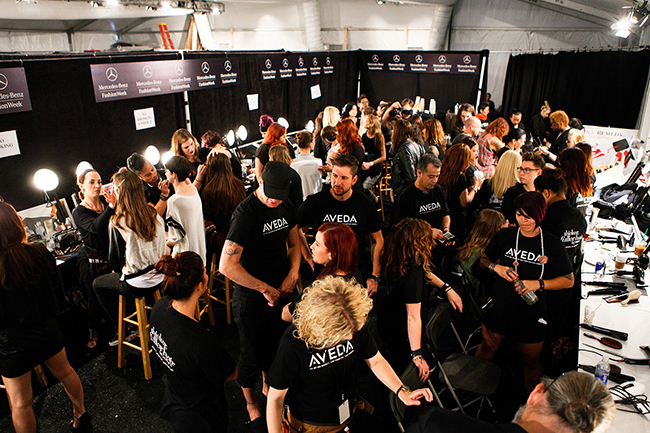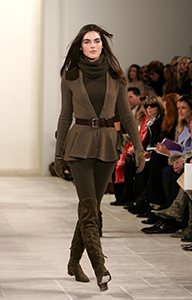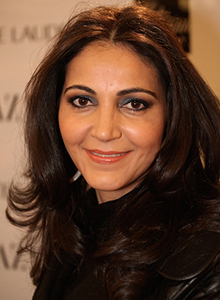Fashion: The Fabric of New York

By Miki Makrillos
Beautiful models, creative designs and a savvy audience all eagerly await the upcoming season’s fashion trends in designers’ displays of artistic expression during the bi-annual New York Fashion Week shows and presentations. The city that never sleeps is well known as the fashion capital in the United States, as well as around the world. Fashion has always been the fabric of New York’s history, economy and lifestyle.
New York’s role as the center of the nation’s garment industry dates back to when tailors produced ready-made clothing for Southern plantation owners, sailors and western prospectors. By the 1820’s, there was an increase in the number of ready-made garments of a higher quality than what was being produced for a broader market. By the 1850’s, industrialization and the invention of the sewing machine created a huge transformation in ready-made clothing. By the 1860’s, Americans bought most of their clothing.

Immigration was another important factor that helped influence New York’s growing garment industry. German and Central European immigrants coming to America around the mid-19th century arrived on the scene with experience and skill in garment production. In the early 20th century, a largely Eastern European immigrant workforce powered the garment trades. With an expansive, as well as inexpensive, workforce and a well-established distribution network, New York became the garment production capitol. By 1910, 70% of the nation’s womenswear and 40% of men’s clothing was produced in New York.
During this period of industrialization and growth another very important factor was developing in New York that would be a big impact on the future of the garment industry. Education and Fashion were destined to join. In 1896, American Impressionist painter William Merritt Chase founded the later named Parsons School of Design. He was later joined by arts educator Frank Alvah Parsons to establish the first Fashion Design program in the United States. As the modern curriculum developed, many successful designers remained closely tied to the school and by the mid-1960’s Parsons became what many dubbed “the training ground for Seventh Avenue”, located in the heart of New York’s famed Garment District. Designers such as Donna Karan, Marc Jacobs, Tom Ford, Alexander Wang, Anna Sui, Jason Wu, and Derek Lam are among the alumni success stories from Parsons School who globally influence fashion trends.
The Fashion Institute of Technology, known as FIT, was the next great New York fashion educational center, founded in 1944 and accredited in 1957. It was ranked among the top five fashion schools in the world. Designers such as Calvin Klein, Michael Kors, and Norma Kamali are among the graduates from the college. FIT was not only a top rated educational center for thousands of future graduates in New York City; but in 2012, the Museum at FIT, which was established in 1969, was awarded accreditation by the American Alliance of Museums. The museum exhibits garments and accessories dating back to the 18th century within its permanent collection. Today, students continue to come from around the world to study fashion in New York.
The Garment District in New York, also now known as the Garment Center and the Fashion District, has played an integral part in New York’s connection to fashion. This district consists of a dense concentration of fashion-related uses (such as studios, designers’ main offices, factories, warehouses and wholesalers) and occupies less than 1 square mile between Fifth and Ninth Avenues from 34th to 42nd Streets. The Garment District has been known since the early 20th century as the center for fashion manufacturing and designs in the United States and the world. There is no other city like New York that has a comparable concentration of fashion businesses and talent in a single area. The concentration of talent, entrepreneurship and wholesalers creates an ecosystem that supports the industry. The Garment District historically would produce garments only blocks away from the luxe retail of Fifth Avenue, including stores like Saks Fifth Avenue, Bergdorf Goodman, and Lord & Taylor, as well as designer flagship boutiques. These stylish, quality retail stores bring in millions in revenue from tourists who come from all over the world to go shopping in the fashion capital. Trendy areas such as Soho and the Meatpacking District have also joined in the fashion connection, drawing many designer flagship stores, tourists and dollars.
For decades, fashion in New York has also been depicted in famous films, such as Breakfast at Tiffany’s, Working Girl, The Devil Wears Prada and Sex in the City to name a few. Moviegoers around the world have been fascinated by what they see on the big screen and yearn to come to New York to experience the magic of fashion in the Big Apple.
Overall, fashion is the fabric of what New York and New York’s lifestyle represent. The city’s history, immigration, education and exposure from media all has inspired the fashion industry and encouraged people from all over the world to come to New York.

About Miki Makrillos
Miki Makrillos is a commentator on style and fashion on her website: wonderwomantalks.com



